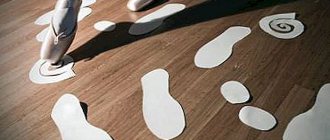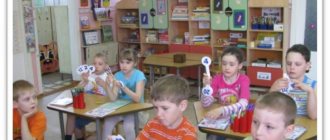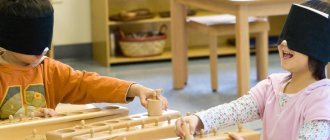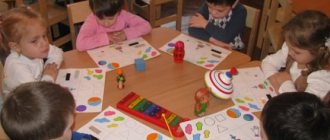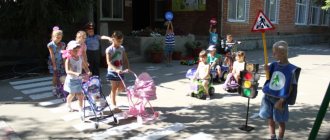Methods of learning songs with preschool children
Methods of learning songs with preschool children.
It is necessary to start working on learning a song from the preparatory stage. Which involves familiarization and analysis of the song, identification of artistic value, educational tasks, technical difficulties, and identification of methodological techniques to overcome them.
Singing abilities vary in each age group. Until the age of 3, children accumulate experience in perceiving music, sensory-auditory and rhythmic concepts, and intonating a melody with their voice. From 3 to 5 years, coordination of hearing and voice, music and movements, and the combination of knowledge and skills occurs. From 5 to 6 years of age, practical actions are supported by knowledge about music, enriched by it, and elements of an aesthetic attitude towards singing and music in general are formed.
In classes with the youngest children, chants and small songs of an imitative nature are used (voices of birds, animals, sounds of the surrounding reality, repeated intonations); it is desirable that the text contains the sounds zh, h, shch.
melodies should be simple, built on 2-4 sounds in the range: re1-sol1.
In children 3-4 years old, the range is: re1-la1, breathing is not yet uniform, short, not everyone has developed articulation and diction. At 4-5 years old, the range expands: re1-si1, breathing is more stable, phrases are drawn out, words are pronounced better. At 5-6 years old the range is from C(re)1 octave to C(re)2 octave. Children have better control of singing breathing and can sing phrases of up to 2 measures at a slow tempo. A more varied repertoire is used, at any tempo and any dynamics.
The work can be roughly divided into three stages.
Stage 1. Emergence of an impression of the song (1-2 lessons).
Introduce children to the song, create emotional interest in its image, reveal the content of the song.
Conversation on the content of the song, viewing a toy or drawing. The title of the song is given and then performed expressively. If the text is difficult to understand, then you need to read it and explain the meaning of unclear words. To give a complete artistic image, the song is performed several times.
2. Stage. Learning a song (3-5 lessons).
— first, the song is taught without musical accompaniment (with an adult’s voice and playing along with the melody), so that children better learn intervalics;
- singing without and with music;
- heavy melodic and rhythmic moves need to be taught separately (children listen to an adult sing and then repeat after him);
- the text must be studied with the melody;
— an individual approach is widely used: children sing together, and then take turns: boys and girls, sitting and standing.
3. Stage. Reinforcing the learned song (from lesson 6).
Work on recreating the musical image of the song, on emotional and expressive performance.
— repetition of songs from the repertoire of one’s own or a previous group in a different key;
- work on the expressiveness of performance (tempo, dynamics, character, singing with soloists, using children's musical instruments);
- performance accompanied by movements, playing musical instruments, staging songs.
QUESTIONS
1. The importance of singing activity in musical and personal development
preschooler.
2. Goals and objectives of children’s singing activities.
3. Age characteristics of the development of voice and hearing in preschool children. Oh at the child's voice.
4. Types of singing activities for children. Characteristics of the repertoire
5. Contents of vocal and choral education in kindergarten.
6. Stages of teaching children to sing. Specifics of teaching methods at each stage of song learning.
LITERATURE
1. Brygina G. Russian folk song as a means of teaching expressive singing // Doshk. upbringing. - 1980. - No. 7. - P. 87.
2. Vetlugina N.A., Keneman A.V. Theory and methods of music education in kindergarten. - M., 1983. - P. 147-157.
3. Vetlugina N.A. Musical ABC book. - M., 1989.
4. Voinova A.D. Development of purity of intonation in the singing of preschool children. - M., 1960. Metlov N.A. Music for children. - M., 1985. - P. 18-50.
5. Methods of music education in kindergarten / Ed. N. Vetlugina. - M., 1989.-S. 76-89.
6. Rada nova O.P. and others. Musical education of preschool children. - M., 1998. - P. 93-98.
7. Stulova G.P. Development of a child's voice in the process of learning to sing. - M., 1992. - P. 111-119, 147 -151, 170-174.
8. Teach children to sing: Songs and exercises for voice development in children 3-5 years old / Comp. T.M. Orlova, S.I. Bekina. - M., 1986.
9. Teach children to sing: Songs and exercises for voice development in children 5-6 years old / Comp. T.M. Orlova, S.I. Bekina. - M., 1987.
MAGAZINE Preschooler.RF
Stages of working with song material for preschoolers.Music is one of the most effective means of educating a person, and singing belongs to the type of art that can be called the most widespread and accessible. Singing is one of the main means of musical education. It is closest and most accessible to children. Children love to sing and sing willingly. By participating in singing, children themselves perform musical works, while they express their experiences, feelings and perceive music more deeply. The words in the song help children understand the content of the music and make it easier for them to learn the melody. Children perceive a melody from a voice more easily than when performed on some musical instrument.
Singing develops in children:
- ear for music
- sense of rhythm
- ability to reproduce melodies by voice from memory
- correct, clear pronunciation of individual sounds and words
- speech, because it is necessary to pronounce the words drawlingly, in a sing-song manner
Singing unites children with a common mood. When performing songs, children learn to work in a team. They hear that those who are in a hurry or lagging behind disrupt the harmony of the singing. Singing promotes the development and strengthening of the lungs and the entire vocal apparatus. According to doctors, singing is the best form of breathing exercises.
Learning a song is one of the most important sections of a musical lesson. At the same time, all the work often comes down to learning the text and mechanically repeating the song. This leads to the fact that children quickly get bored with the song, often remaining unlearned. To prevent this from happening, the teacher needs to clearly understand that learning a song is a long and interesting process. The music director (teacher) must clearly understand what he wants to achieve from children at the moment, be able to clearly set a specific task for the children and try to select techniques that are not only appropriate, but also interesting for the children.
The process of working on a song repertoire consists of several stages:
1. Selection of song material
Songs should be selected taking into account the age characteristics of the students. It is necessary to select song material for preschoolers based on accessibility and easy-to-memorize text and vocal melody with a narrow range within the sixth of the first octave.
2. Processing of song material:
A) If we see that the melody of the song is written too high, for a child’s voice, then we can simply change the key, i.e. transpose a song to a different key.
B) If you liked the found song material in terms of the semantic content of the text and the beauty of the melody, but it is clear that it will be difficult for children to reproduce the vocal part of the song, then you can adjust the melody based on the children’s capabilities while maintaining the harmonic structure of the work:
C) If there are not enough verses to reveal the plot of the song or for some reason it is necessary to change the words in these verses, then you can complete and add your own words to the song:
Kiss
Sl. and music E.V. Gorbina
In the morning I get up and kiss you. In the evening I go to bed and kiss you. If you're tired, I'll kiss you. If you scold me, I’ll kiss you.
If I'm naughty, I'll kiss you. If I spill milk, I’ll kiss you. Only you better have pity on me - On the cheek, mommy, kiss me quickly.
| Kiss Sl. and music E.V. Gorbina In the morning I get up and kiss you. In the evening I go to bed and kiss you. If you're tired, I'll kiss you. If you scold me, I’ll kiss you. If you're bored, I'll hug you. I'm happy to see you - I'll hug you. I want to always be with you. We are not afraid of obstacles with you. If I mess up, you will scold me. If I spill milk, you will scold me. Only you better have pity on me - On the cheek, mommy, kiss me quickly. |
- 1. Demonstration of song material
And so, we come to the practical part of working on new song material. Before you start learning a song, it must be demonstrated to the children in the form in which it will be heard in their performance. To do this, the teacher performs the song in the form in which it will be performed (with a piano or a musical soundtrack). Next, the children answer the question: “What or who is this song about?”
- 2.Work on the words of the song
It is necessary to learn the words of a song in verses line by line (this makes it easier for children to remember) according to the “echo” principle: the teacher pronounces the line and the children repeat it. Next, the teacher asks to repeat the entire verse with him, and then the children pronounce the verse on their own. And we are also working on the chorus. To prevent the work from being mechanical, you can pronounce words with different intonations. In order for the next stage to proceed without any particular difficulties, it is necessary to learn the lyrics to the rhythm of the melody, because it will be very difficult to retrain.
- 3. Connecting words and melody
First, we connect the melody and the words of the first verse. The teacher independently shows how it should sound, for this he plays a melody on the instrument and at the same time sings the first verse. Then he repeats this verse, but this time together with the children and for reinforcement, the children sing independently to the accompaniment of the teacher. The same algorithm of actions applies to the chorus.
- 4. Consolidate the song and work on the quality of performance
Only repeated repetition gives strength to the assimilation of a song. At this stage, variability of tasks is required when repeated due to the method of sound engineering, timbre, dynamics, and emotional expressiveness. The stage of work on quality of execution is the most difficult and lengthy. This stage represents work to achieve an ensemble - intonation, rhythm, diction. To do this, it is necessary to instill in children the skill of LISTENING and HEARING each other.
- 5. Concert performance
It should be noted that working on a song requires great tact and patience from the teacher. The main method of influencing children should be praise. If we are not satisfied with something in the children’s singing, it is better to invite them to repeat the song again or use another technique. Concert performance is the most important moment for children. Each song requires its own stage implementation, therefore it is the nature of the song that determines the statics or dynamics of the stage solution. It is this stage that allows children to understand and, most importantly, to feel why and for what purpose we sing.
| < Previous | Next > |
Other abstracts on the topic “Pedagogy”:
- First pedagogical experience as a condition for the formation of prerequisites for professional and pedagogical deformations
- Correction of spiritual and moral qualities in children of primary school age with visual impairments
- Design in AutoCAD 2009
- Using multimedia tools when studying the properties of a power function in a secondary school
- The interrelation of various types of activities and their role in the development of a conscious attitude towards nature
Learning the song repertoire. Outline of a music lesson (senior group) on the topic
Topic of the lesson: “Learning the song repertoire”
The date of the:
April 16, 2014
DDT,
pupils of the early development studio “Znayka”,
Group 2, 1st year of study, 5-7 years
Goal: learn the song “We are sorry to part with you.” music etc. I. Ponomareva
Tasks:
educational: teaching ensemble singing, teaching singing in unison, achieving pure intonation
developing: to develop an ear for music, rhythmic expressiveness, its advanced movement, musical memory, voice, sense of rhythm
educational: to form creative activity, tolerant thinking.
Equipment: button accordion, stereo, bell, visual materials.
Lesson plan
1. Organizational moment (2 min). 2. Main part. 10 minutes
1) Musically rhythmic movements.
2) Auditory. 3. Practical part (15 min).
Learning the song “We are sorry to part with you.” music etc. I. Ponomareva
4. Result - 3 minutes
Progress of the lesson
1. Organizational moment.
Teacher: Guys, look, a balloon flew to us, what color is it?
Children: Red.
Teacher: Oh, look at it, something is written, “Hello” we say this word every morning. You know, you can also sing this word, listen to me sing it, and then you will be little composers.
Children: Hello.
Teacher: Well done, we said hello to you today
2. Main part.
Musically rhythmic movements
Teacher: And let’s do some exercises with you. Now you and I will walk with a cheerful, cheerful step, raising our knees and raising our backs and heads.
“We walked” “This is how we can” “Palm”, etc.
Auditory
Teacher: Guys, look who came to visit us, a musical bell. He can play quiet and loud music, just listen.
(play p and f)
Teacher: And now you guys will be musicians, play the bell.
(play)
Teacher: Well done guys. What musical instrument came to visit us?
Children: Musical bell
Teacher: What kind of music did you play?
Children: Quiet and loud
Teacher: Let's wake up our hands. The music will play “p”, hit the finger on the finger, and when the “f” changes, then clap your hands.
(playing)
3. Practical part
Teacher: What do you think, when a person sings, what organs, what parts of our body are brought into action?
Children: mouth, tongue, ears. Teacher: Do your legs, arms, head, face work?
Teacher: Of course. When we sing, not a single cell of our body is left without participation. Now, standing with your arms to your sides, take a deep breath in through your nose, and as you exhale, cross your arms in front. (done several times)
Chew imaginary bubble gum. Say the syllables: bra-bra-bru, gra-gra-gru, dra-dra-dra.
Listen to the song and tell me what it is about and what its character is?
Today we will learn a new song “We are sorry to part with you.” music etc. I. Ponomareva
Learning the song “We are sorry to part with you.” music etc. I. Ponomareva
The work is carried out in phrases.
Result:
Teacher: Well done, guys, we did a lot today, we accomplished a lot. What is the name of the song we met today?
Children:
What new things did you learn from this song? Did you like the song? I wish you to always be friends with the song. Guys, who came to visit us today?
Children: Sharik
And when someone leaves, we say “Goodbye” and let’s not just say it to the ball, but sing it.
Children: "Goodbye"
Latest abstracts of the section
- Trends in the development of the higher education system in Ukraine and abroad: main directions
- The influence of a health-saving approach in organizing educational work on the formation of valeological literacy in primary schoolchildren
- Characteristics of the competencies of bachelors – educational psychologists
- Corrective program to reduce anxiety in children of primary school age using clay therapy
- Formation of vocabulary in preschool children with general speech underdevelopment
- The role of visibility in teaching fine arts
- Active theoretical teaching methods
Copyright © 2010-2021 — www.refsru.com — abstracts, coursework and dissertations
